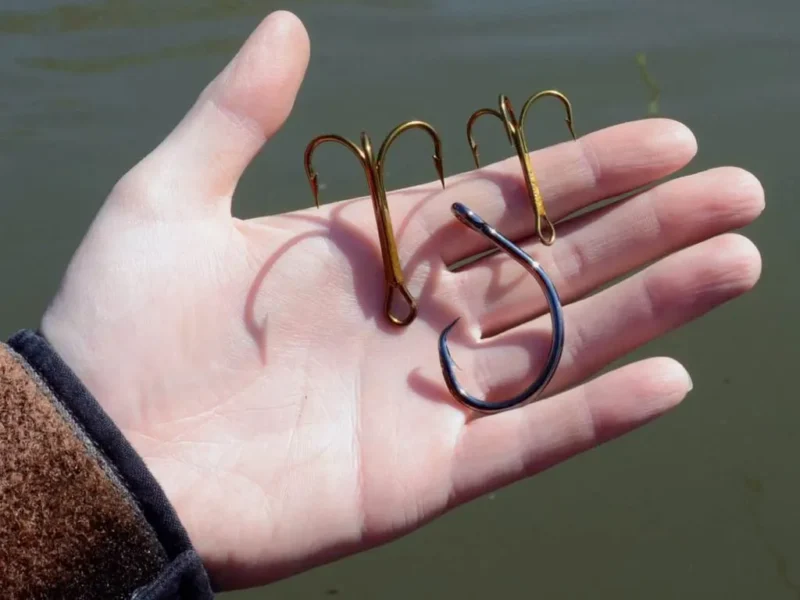Fishing success begins with choosing the right hook. Many anglers underestimate the role that hook design plays in setting bait, hooking fish cleanly, and minimizing harm to the catch.
Every shape, gap, curve, and barb serves a specific function. Selecting the wrong type leads to missed strikes, lost fish, or damaged bait. Each target species, lure setup, and fishing condition demands a hook built for that exact scenario.
Most hook types trace their roots to classic designs that evolved to fit new fishing strategies. Freshwater and saltwater environments bring different challenges. Fish like bass, carp, and tuna require distinct rigging methods.
Live bait calls for one shape, soft plastics another. Even catch-and-release fishing needs a special approach to protect fish health.
This guide breaks down every major fishing hook type. Each entry highlights the shape, purpose, and best use case. Whether you fish casually at the lake or target giant species offshore, this reference helps you match the right hook to the job.
Every hook has a role. Knowing which one to use puts more fish in the net and fewer problems on the line.
1. J-Hook
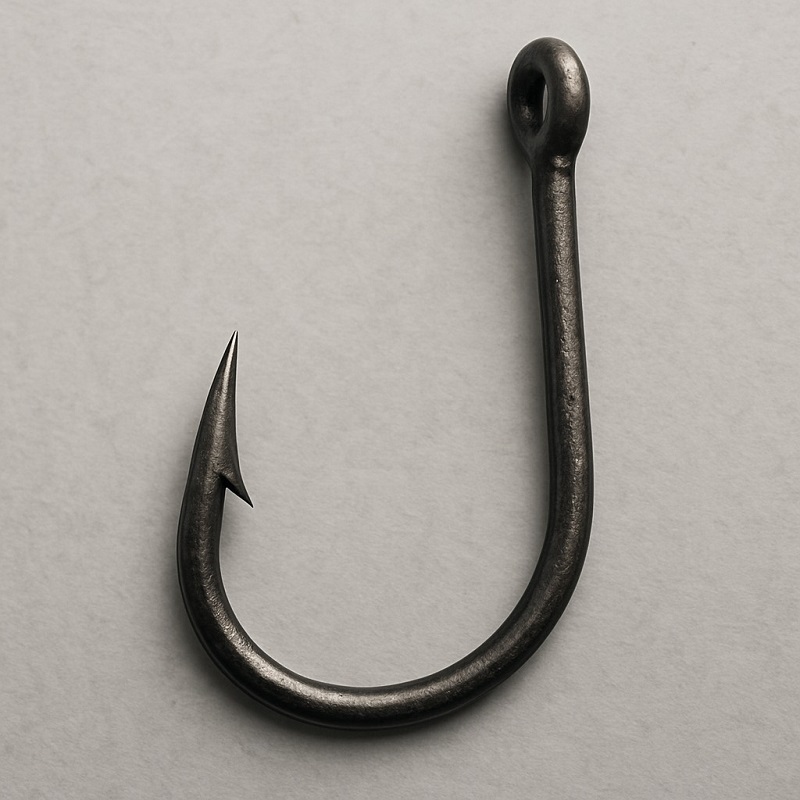
The J-Hook holds the most familiar shape among all fishing hooks. Its curved design and straight shank follow a basic structure that works in many fishing scenarios. This hook relies on a strong and deliberate hookset.
When used correctly, it penetrates deep and holds firm. The risk lies in the angle of entry. Many fish end up gut-hooked if the angler reacts too slowly.
Some variations feature barbs along the shank for better bait grip. Most freshwater and saltwater anglers include J-Hooks in their standard tackle box. However, they work best in the hands of those who understand timing and hook placement.
When to choose a J-Hook
J-Hooks perform best when fish strike hard. Use them with fast retrieves, aggressive species, or bait presentations that demand stability. Avoid passive setups where delayed hooksets increase the chance of deep hooking.
2. Circle Hook
Circle Hooks curve inward at the point, forming a near-complete loop. Unlike the J-Hook, this one does not require a snap hookset. Instead, it relies on steady pressure. As the fish swims off, the hook rotates naturally into the corner of the mouth. This reduces injury and makes release easier.
Circle Hooks have grown in popularity with saltwater anglers and conservation programs. Their effectiveness depends on patience. Jerking the line ruins the process. Those who fish hands-free or leave rods in holders benefit most from the automatic set action of a circle design.
Perfect applications for Circle Hooks
Use Circle Hooks for bottom rigs, live bait, or passive rod setups. They shine in catch-and-release fishing and meet many tournament regulations. Best results come with non-barbed or barbless variants when minimal fish damage matters.
3. Treble Hook
Treble Hooks contain three barbed points sharing a single shank. Found mostly on artificial lures, they increase the odds of hooking a fish during a strike. Each point faces outward, making accidental hookups more likely. They also cause more injury to fish and tangle in nets or clothing.
These hooks shine on crankbaits, spoons, and topwater lures. Anglers who target species that swipe or slash at bait—like pike or bass—find treble hooks highly effective. Their main weakness appears during snaggy conditions where the triple point catches debris or structure.
Best uses for Treble Hooks on lures
Perfect for reaction lures that trigger fast strikes. Avoid heavy cover or weedy spots. Replace or upgrade factory trebles on store-bought lures for better control and reliability.
4. Octopus Hook
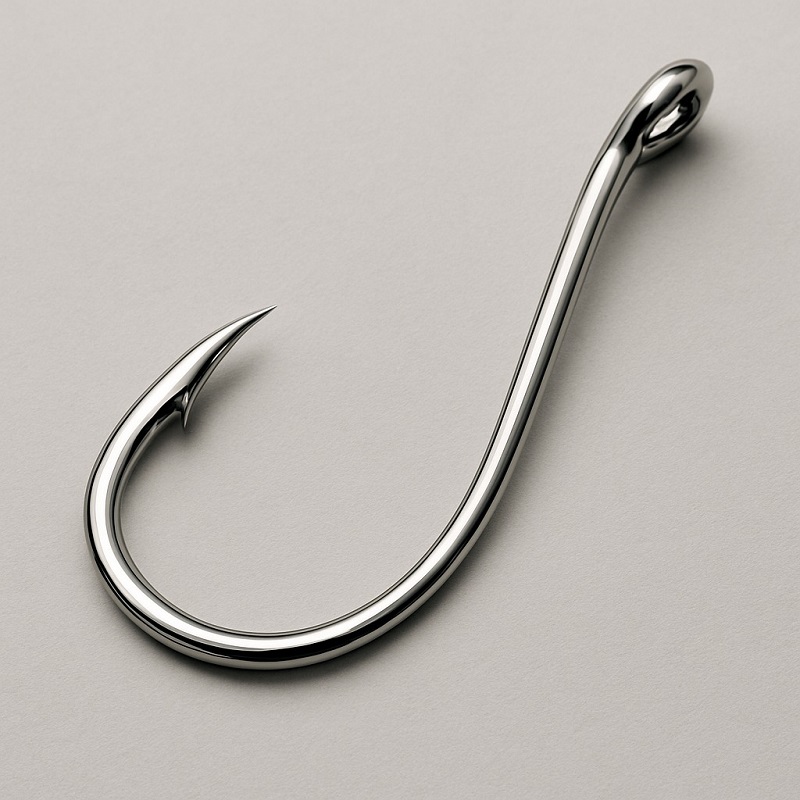
Octopus Hooks feature a short shank, a wide gap, and an upturned eye. The compact profile helps when fishing with smaller baits. Many anglers choose it for finesse rigs, drop shot presentations, or nose-hooking live bait. The point usually tilts slightly inward, offering secure hooksets without deep penetration.
This hook suits delicate rigs. It supports a light line and small bait without tearing or slipping. Its shape works well for fish that nibble or peck. Despite its size, it holds surprisingly well under pressure.
Smart ways to deploy Octopus Hooks
Match with small soft plastics, minnows, or finesse rigs in calm water. Ideal for trout, perch, or walleye fishing where subtlety matters more than brute force.
5. Aberdeen Hook
Aberdeen Hooks come with a long, thin shank and light wire construction. Designed for easy hook removal, they work best with soft-bodied bait like worms or minnows. Their wire bends under pressure, allowing the angler to pull it free from snags. This feature makes it a favorite in brush-heavy freshwater spots.
The long shank gives more surface area to hold bait. It also helps remove the hook without damaging the fish or line. Due to the thin wire, they suit light tackle and smaller species.
Strategic value of the Aberdeen Hook
Use Aberdeen Hooks in weedy or submerged structure zones where snagging happens often. Match with nightcrawlers, small minnows, or dough bait for panfish, crappie, and bluegill. Avoid large predators that might bend the hook.
6. Siwash Hook
The Siwash Hook features a long, straight shank and an open eye. Most anglers use it as a replacement for treble hooks on spoons, spinners, or hard baits. Its single point causes less damage and makes catch-and-release easier. The open eye allows simple attachment to split rings or lure hardware.
This hook offers better strength and fewer snags compared to trebles. Its narrow gap suits long-bodied baits. Many saltwater and freshwater anglers prefer it when targeting aggressive species that thrash during the fight.
When to swap in a Siwash Hook
Ideal for converting lures to single-hook setups. Best choice for salmon, steelhead, or trout in rivers or estuaries. Works well when regulations ban treble hooks or when snag control matters.
7. Worm Hook
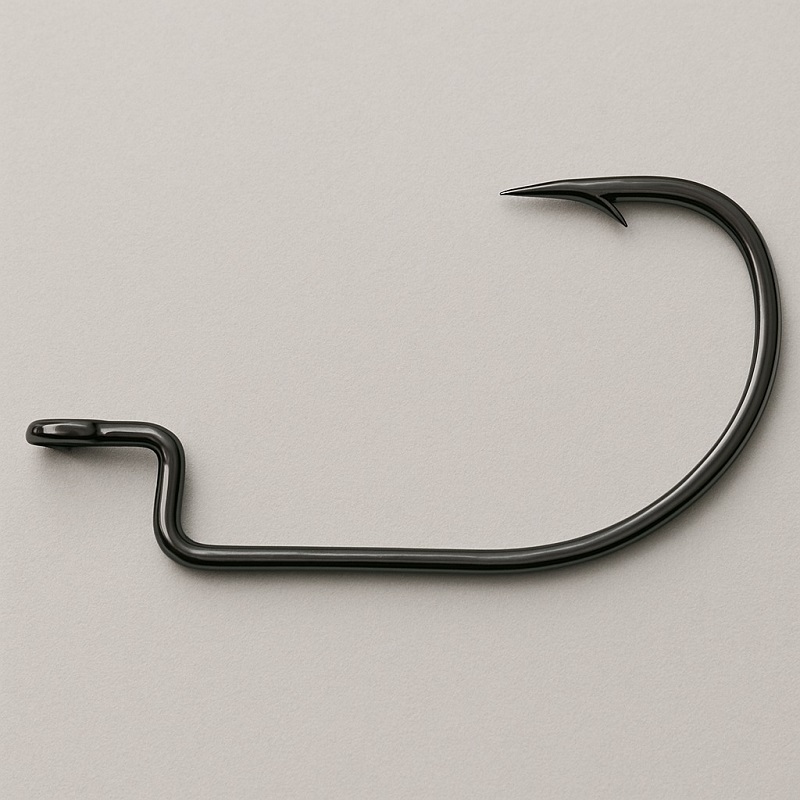
Worm Hooks are designed for rigging soft plastics. Their structure includes an offset shank and a wide gap to accommodate bulky artificial baits. Bass anglers rely on this hook to present worms, creature baits, or lizards with natural movement and clean line angles.
Most versions include a bend near the eye that secures the bait. This holds the plastic in place without tearing. The wide gap allows for better hook penetration once the fish clamps down on the lure.
Perfect pairings for the Worm Hook
Use for Texas rigs, Carolina rigs, or weedless presentations in heavy cover. Works best for largemouth bass, especially in lakes or ponds with submerged logs, grass, or thick weeds.
8. Weedless Hook
Weedless Hooks include a guard or wire that covers the point and prevents snagging. These hooks thrive in vegetation-heavy areas. The design allows bait to slide past weeds or branches without catching. Once a fish bites down, the guard compresses and exposes the hook point.
The weedless feature comes in many forms. Some use a plastic shield, others a metal wire. The goal stays the same: allow casting into dense cover without constant fouling or snags.
Why Weedless Hooks dominate heavy cover
Essential for fishing frogs, soft plastics, or jigs in lily pads, reeds, or submerged brush. Use when fish hide in structure that blocks traditional hooks. Match with aggressive, ambush-style fishing patterns.
9. Kahle Hook
The Kahle Hook combines the wide gap of a worm hook with the shape of a J-Hook. Its offset point improves hookup ratios and allows bait to move more freely. Live bait stays active longer, making this hook ideal for species that stalk and inhale prey.
Many anglers use Kahle Hooks for catfish, bass, or saltwater gamefish. The bend offers enough gap to accommodate larger baits while keeping the hook exposed. It works well in both freshwater and brackish systems.
When Kahle Hooks outperform others
Choose for live bait rigs targeting species with big mouths or soft strikes. Works best with shiners, shrimp, or cut bait in slow to moderate current. Avoid in tight cover where the open shape may snag.
10. Sickle Hook
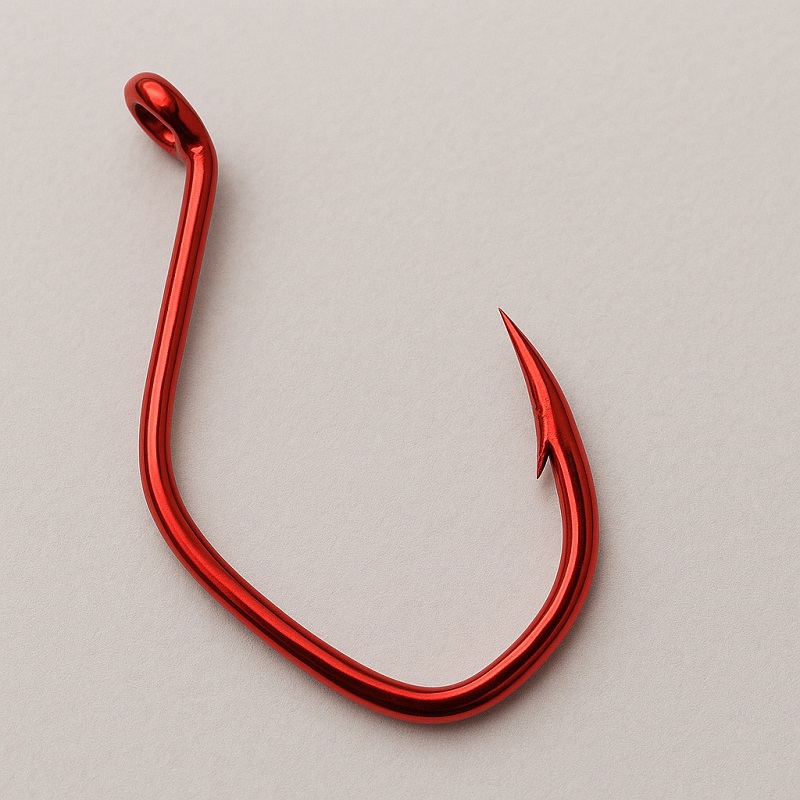
Sickle Hooks feature a sharply angled bend that resembles a sickle blade. The unique shape increases hook penetration and provides a firm hold once set. Unlike rounded bends, the sickle shape creates pressure points that lock into tissue more effectively.
These hooks see frequent use in crappie jigs or finesse setups. The wide gap and firm point make them dependable for smallmouth bass, panfish, or even ice fishing. Their shape reduces flex and improves hookset consistency.
Practical uses for the Sickle Hook
Best suited for vertical jigging, finesse plastics, or feathered jigs. Use when targeting fish with soft mouths or light bites. Works in both clear and murky water where instant hookset matters.
11. Weighted Worm Hook
The Weighted Worm Hook builds on the standard worm hook design but includes a molded weight along the shank. This added weight helps soft plastics sink faster and maintain a natural fall. It also improves casting distance, especially with lighter baits.
The hook still features an offset bend to hold the bait securely. By positioning the weight near the belly of the lure, the bait swims level through the water column. This hook shines when targeting fish suspended around drop-offs or submerged structure.
Smart deployment of Weighted Worm Hooks
Use when fish hold deeper or when extra casting range is needed. Ideal for Texas-rigged soft plastics in open water or sloped banks. Effective for largemouth bass in deep lakes or reservoirs.
12. Weighted Treble Hook
The Weighted Treble Hook adds mass near the base of the triple-pronged design. Found mostly in rigs meant to sink quickly, it pulls baits or lures downward without changing their original profile. Some anglers add them to snagging rigs, stinger hooks, or modified swimbaits.
The added weight must be used with caution. It alters lure action and can increase snag risk. However, it gives better control during vertical presentations or when fishing around fast currents.
When Weighted Treble Hooks make sense
Use for vertical jigging, ice fishing, or custom bait rigs. Common with baitfish harnesses targeting lake trout, pike, or muskie. Avoid in heavy vegetation or dense cover.
13. Double Hook
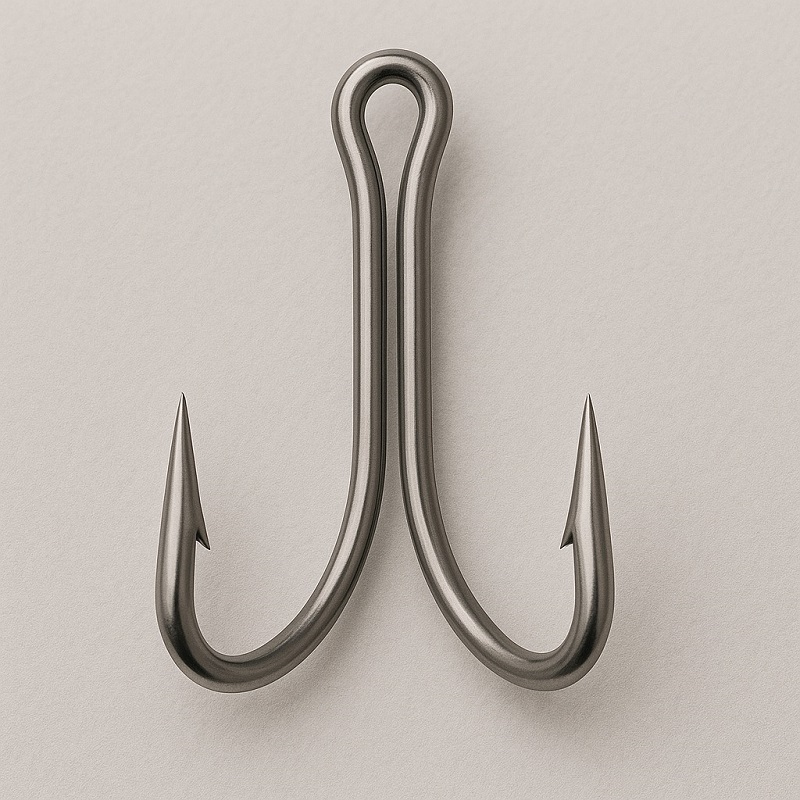
The Double Hook includes two points facing outward, joined by a shared shank. Some variants come with both points aligned in the same direction, while others split the angle. This hook appears most often in topwater frog lures, spinnerbaits, or stinger-style bait rigs.
Compared to trebles, double hooks offer better penetration and fewer entanglements. They also help with bait stability and give cleaner hooksets when rigged properly.
Specific uses for Double Hooks
Best suited for hollow-body frogs, inline spinners, or baitfish harnesses. Use when trebles cause too much damage or snag too often. Effective when fish strike short or swipe at the tail end of the lure.
14. Jig Hook
The Jig Hook includes a 90-degree bend near the eye, allowing the angler to pair it with a molded jig head. This hook works with soft plastics, bucktail hair, or silicone skirts. The sharp bend helps the lure sit horizontal in the water, which appeals to bottom-feeding fish.
Jig Hooks come in many sizes and wire gauges. Some include barbs on the collar to hold bait better. The hook rides upright, reducing snags when bounced along rocks or gravel.
Ideal techniques for Jig Hooks
Use for vertical jigging, slow dragging, or lift-drop techniques. Match with grubs, paddle tails, or tubes for species like walleye, smallmouth bass, or lake perch. Best in rocky or sandy bottoms where the lure needs to stay in contact with structure.
15. Baitholder Hook
The Baitholder Hook features barbs along the shank that grip bait more effectively. These barbs prevent worms, minnows, or cut bait from sliding down or spinning during the cast. The hook point usually includes a standard barb for penetration.
This hook works best with natural baits that tend to tear or fall off. Anglers often use it in bottom rigs, drop shot setups, or float presentations where secure baiting is key.
Strong bait control with Baitholder Hooks
Perfect for bottom fishing with worms, shrimp, or cut bait. Use when casting long distances or when fishing in current. Helps in both freshwater and saltwater environments where soft bait needs to hold position.
16. Offset Hook
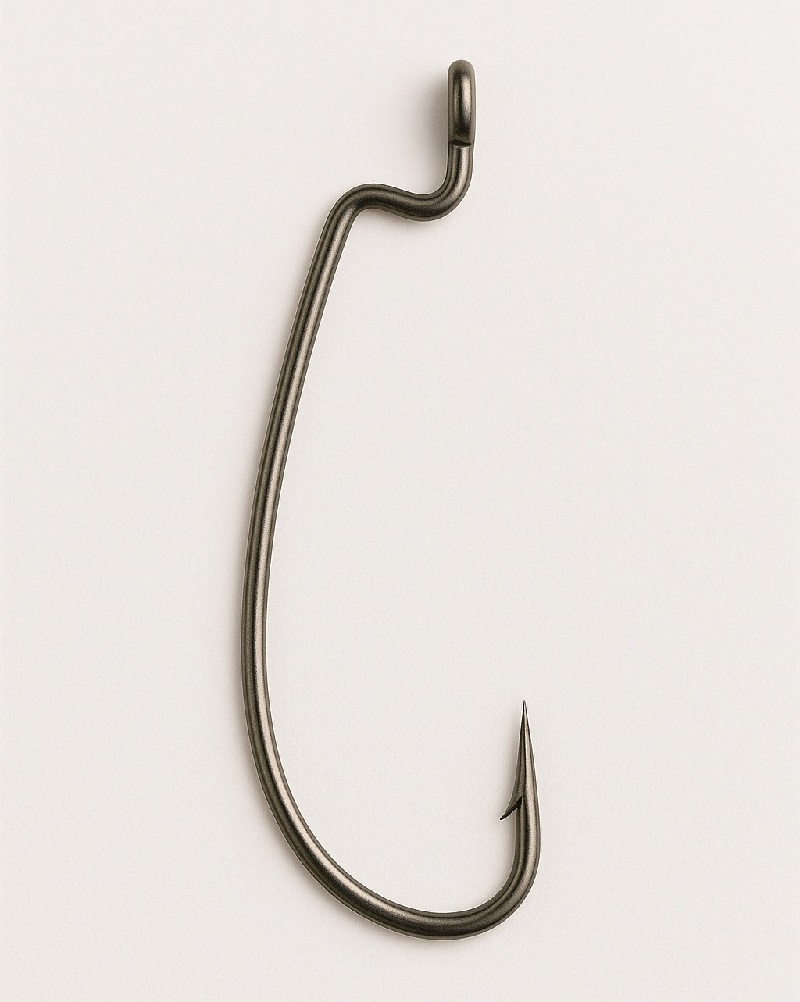
The Offset Hook includes a slight twist in the shank that positions the hook eye and point out of direct alignment. This design improves the hookup ratio by increasing the angle of contact when a fish bites. The offset section also helps soft plastics stay straight and resist sliding.
Most offset hooks feature wide gaps to accommodate thicker baits. The small twist adds enough tension to keep the lure secure through casts and strikes. This hook supports aggressive setups where fast hooksets are critical.
Tactical edge of using Offset Hooks
Choose Offset Hooks when rigging creature baits, tubes, or larger worms. Best in flipping, pitching, or skipping situations where control and presentation must stay clean. Works especially well in thick cover where precision matters.
17. Live Bait Hook
Live Bait Hooks offer a compact shape with a short shank, round bend, and strong build. They are crafted to minimize harm to the bait while keeping the hook firmly placed. These hooks let live bait swim freely and stay active longer, which increases the chances of attracting strikes.
Some versions come with a slightly turned-in point to help secure lip-hooked or back-hooked minnows. The strength of the wire matters most here, as it needs to resist bending when big fish take hold.
When Live Bait Hooks perform best
Use for drifting, slow-trolling, or stationary setups involving live shiners, herring, or shrimp. Best suited for predatory fish that respond to natural motion. Popular among walleye, striped bass, and redfish anglers.
18. Drop Shot Hook
The Drop Shot Hook is compact with a wide gap and upturned eye. It is specifically made for drop shot rigs, where the hook stands horizontally off the mainline and above the weight. This keeps the bait suspended just above the bottom, ideal for finesse presentations.
Its small profile pairs with light tackle and thin lines. The sharp bend allows nose-hooking small plastics, letting them move freely with current or rod twitches. This hook excels when fish hesitate or pressure levels run high.
Finesse advantage with Drop Shot Hooks
Perfect choice for clear water, deep structure, or pressured fish. Use with slender soft baits like minnows, worms, or leeches. Ideal for smallmouth and spotted bass when they suspend near the bottom but stay selective.
19. Wacky Hook
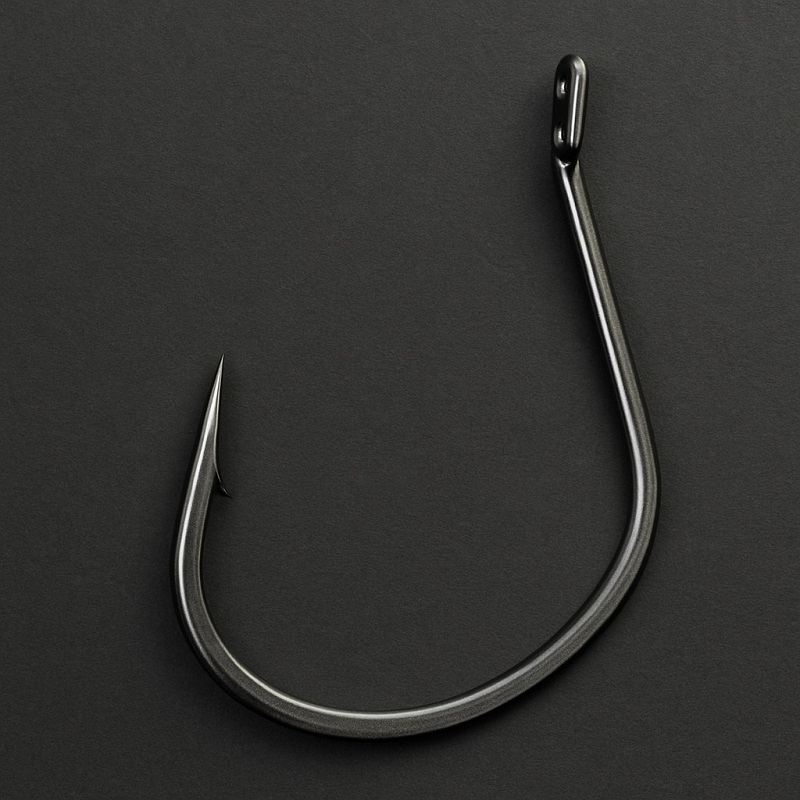
Wacky Hooks are short, round, and built with a wide gap to support the wacky rig style. The soft plastic worm gets hooked through the middle, allowing both ends to flutter independently. This produces a subtle, lifelike motion that attracts hesitant fish.
The shape ensures that hook points stay exposed despite the bait’s position. Some models include weed guards for fishing near cover. Others use thin wire for finesse applications.
Key setups for Wacky Hooks
Use during spawning season, in calm water, or around docks and shallow structure. Best with stickworms or senko-style plastics. Bass often respond with soft takes, so pair with light line and spinning gear.
20. Circle Sea Hook
The Circle Sea Hook is a heavy-duty version of the classic circle hook, tailored for saltwater use. It keeps the inward point that minimizes gut-hooking, but adds extra thickness and strength to withstand powerful ocean species.
Saltwater environments demand corrosion-resistant materials. Most Circle Sea Hooks come in stainless or coated finishes to prevent rust. The hook’s geometry favors mouth corner hookups, making it reliable for catch-and-release in offshore fishing.
Optimal use of Circle Sea Hooks
Essential for bottom fishing or chunk bait rigs in saltwater. Use for snapper, grouper, shark, or cobia. Choose when using rod holders or trolling setups that do not rely on sudden hooksets.
21. Tuna Hook
The Tuna Hook ranks among the strongest designs available. Its short shank, heavy wire, and ultra-sharp point deliver unmatched holding power. Built to handle extreme stress, this hook resists bending or breaking against high-speed runs and deep fights.
These hooks serve as the foundation for big game trolling rigs, chunk setups, and live bait presentations. The point remains exposed at all times, making every bite count. Anglers depend on it for species that crush gear under pressure.
Tuna Hook setups for high-stress conditions
Use for yellowfin, bluefin, and other pelagic species during offshore trolling or chunking sessions. Rig with wire leaders or heavy mono. Works best when fishing with strong rods, reels, and drag systems.
22. Carp Hook
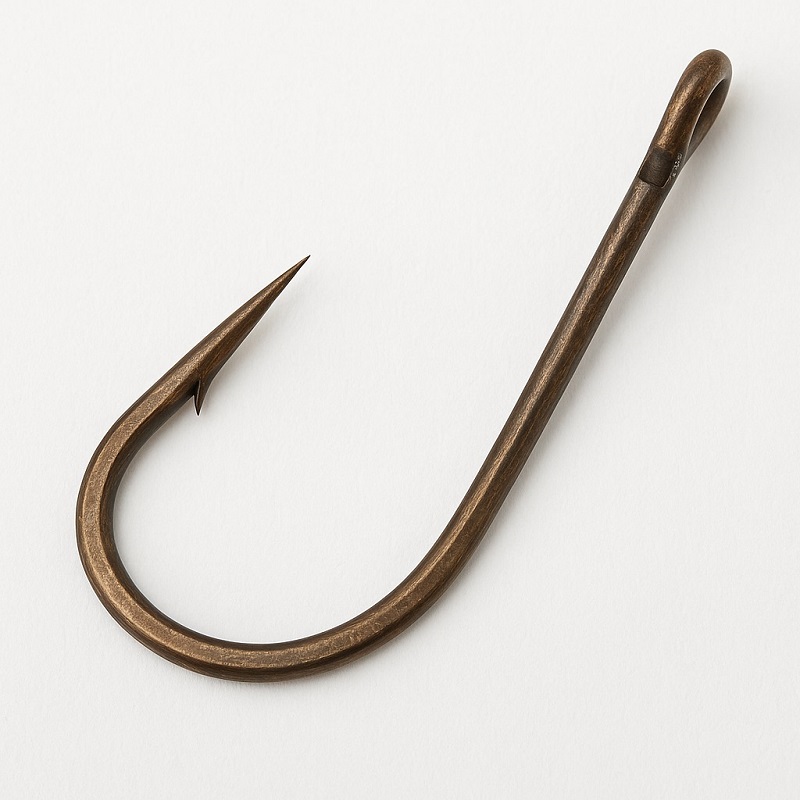
The Carp Hook includes a wide gap, short shank, and curved point that suits the lip structure of carp. It allows solid hookups without tearing soft tissue. Many carp-specific versions include a non-reflective finish to avoid spooking fish in clear water.
This hook pairs with hair rigs, corn setups, or boilie systems. Its low profile and sharpness help keep presentations subtle. The barb or micro-barb prevents fish from shaking the hook mid-fight.
Why Carp Hooks lead European bait rigs
Essential for hair rigging where bait sits off the hook. Best for still water or slow-moving rivers. Use in combination with bite alarms, indicator systems, or method feeders.
23. O’Shaughnessy Hook
The O’Shaughnessy Hook comes with a long shank, thick wire, and straight eye. Its durable structure makes it popular in both saltwater and heavy-duty freshwater fishing. The hook features a deep bend and sharp point, ideal for cut bait and large predators.
This hook type serves as a base for many jigs and trolling rigs. Its design ensures consistent strength under load. Anglers often rely on it in surf casting, pier fishing, or offshore bottom rigs.
Rugged applications for the O’Shaughnessy Hook
Use for tarpon, striped bass, or surf species with large cut bait. Strong enough for high-drag setups in deep or fast-moving water. Suitable for those needing reliability across mixed conditions.
24. Beak Hook
The Beak Hook includes a curved point that looks like a bird’s beak. This shape helps keep bait in place and improves hold during fights. It penetrates easily but focuses on mouth corner hookups rather than deep sets.
The wide gap and sharp bend give flexibility for many bait styles. It is especially effective when fishing live or cut bait in strong current or tide.
Beak Hook in tidal fishing
Use in estuaries, harbors, or tidal rivers where fish hold in current. Effective for catfish, redfish, or snook using shrimp, squid, or mackerel chunks. The hook stays sharp and resists slippage under pressure.
25. Wide Gap Hook
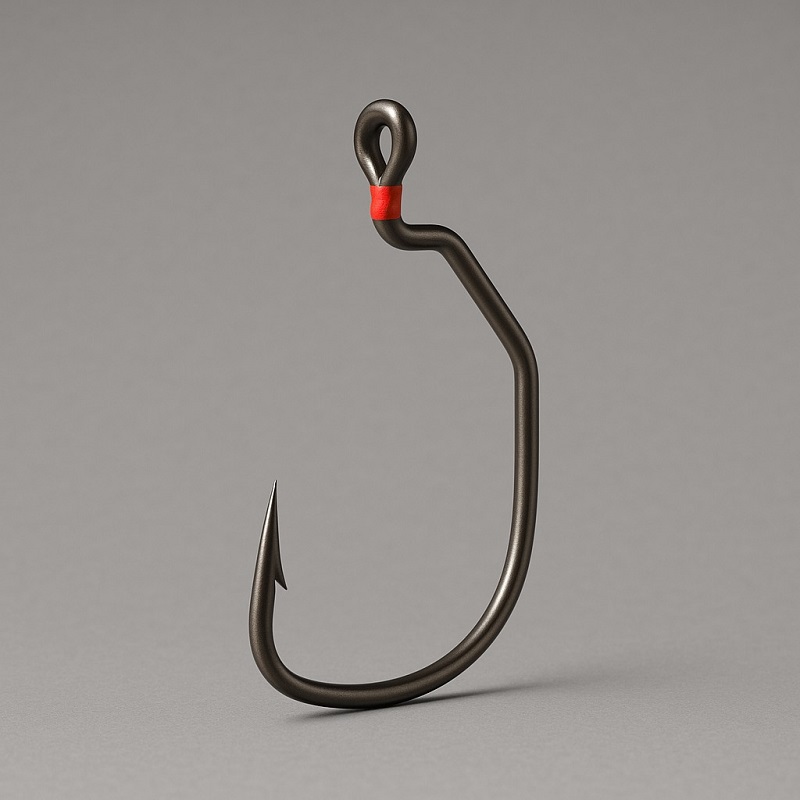
The Wide Gap Hook features an extended distance between the point and shank. This makes room for bulky or thick-bodied baits to compress easily during a bite. It allows better penetration and a clean hookset even through soft plastic or heavy lures.
Bass anglers often use it with swimbaits, tubes, or fat worms. The wide gap provides more surface contact, increasing hookup efficiency.
Advantages of Wide Gap designs
Choose when fishing with thick soft plastics or when bass short-strike baits. Use in moderate cover or open water with structured rigs. Helps maintain bait profile without compromising hook exposure.
26. Long Shank Hook
The Long Shank Hook offers an extended shaft between the eye and bend. This design makes hook removal easier, especially when targeting small fish. It also allows better bait threading and more controlled presentation.
Its slim profile suits light bait like worms or maggots. The added length provides leverage during hook removal, reducing fish injury.
Situations where Long Shank Hooks shine
Use for crappie, bluegill, or perch where bait control and gentle unhooking matter. Common in float rigs or still water bottom setups. Best in areas with schooling panfish or light-biting species.
27. Short Shank Hook
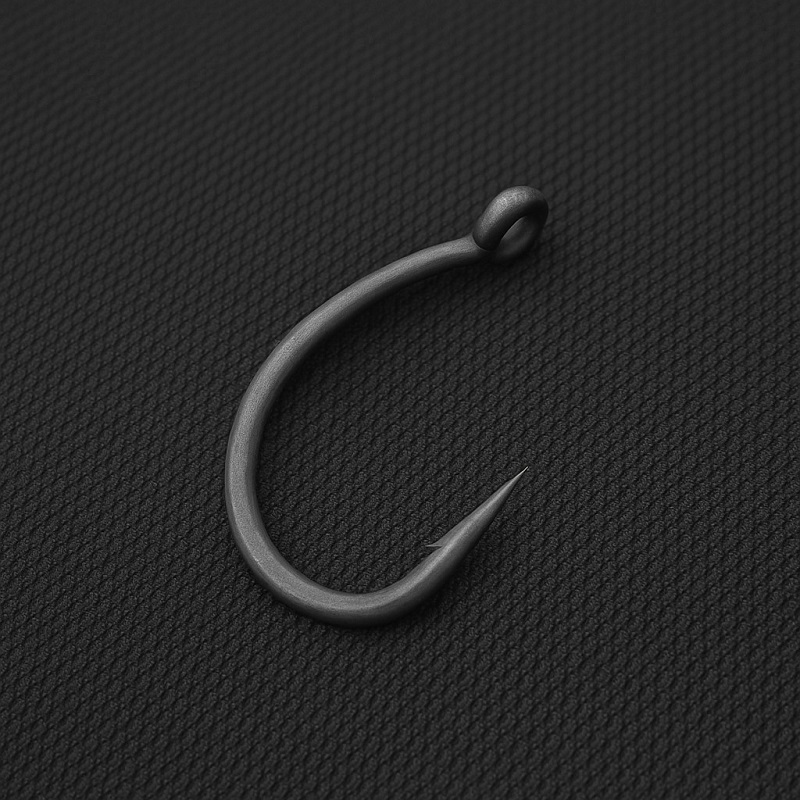
The Short Shank Hook compresses the hook structure into a tighter form. It holds fish firmly with less leverage to shake free. This type supports compact lures or bait rigs where minimal space helps reduce snags.
Often used on jigs, trebles, or trailer hook systems. It keeps the hook point closer to the body of the bait for a tighter action. Some variants include heavy wire for saltwater strength.
Key roles of Short Shank Hooks
Perfect for jig trailers, feathered hooks, or compact bait clusters. Use when fish strike quickly or target the rear section of lures. Effective in both aggressive casting and vertical jigging scenarios.
Last Words
Matching the right hook to the species, environment, and technique creates balance. Picking the wrong one leads to lost fish, ruined bait, or damaged rigs. Every part of the hook, from the point to the shank, carries a purpose. Anglers who know those details catch more and lose less.
No hook works everywhere. There is no universal shape. A well-stocked tackle box carries variety, not duplicates. Study each hook. Understand when to use it. Keep the line tight, the bait natural, and the hook sharp. Mastery begins with knowing what hangs at the end of your line.

